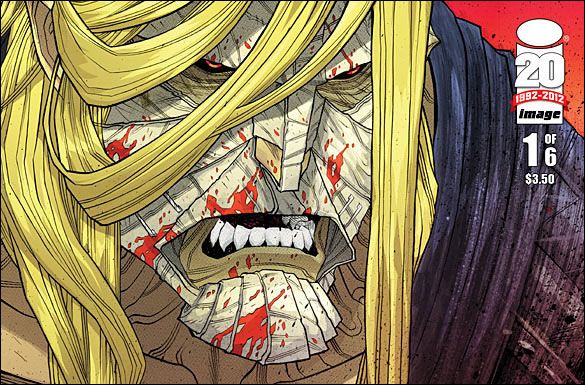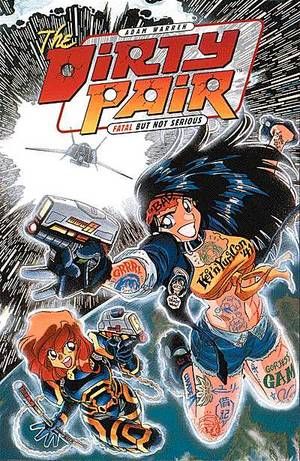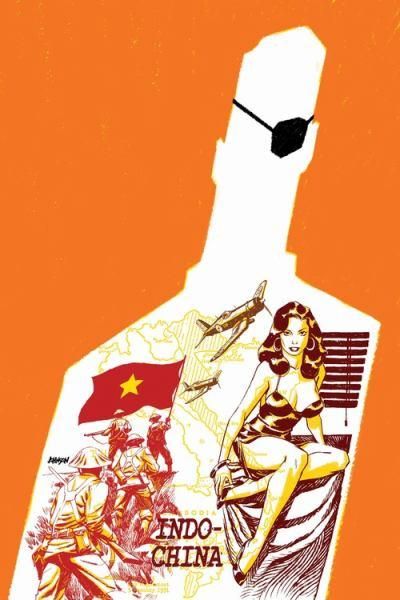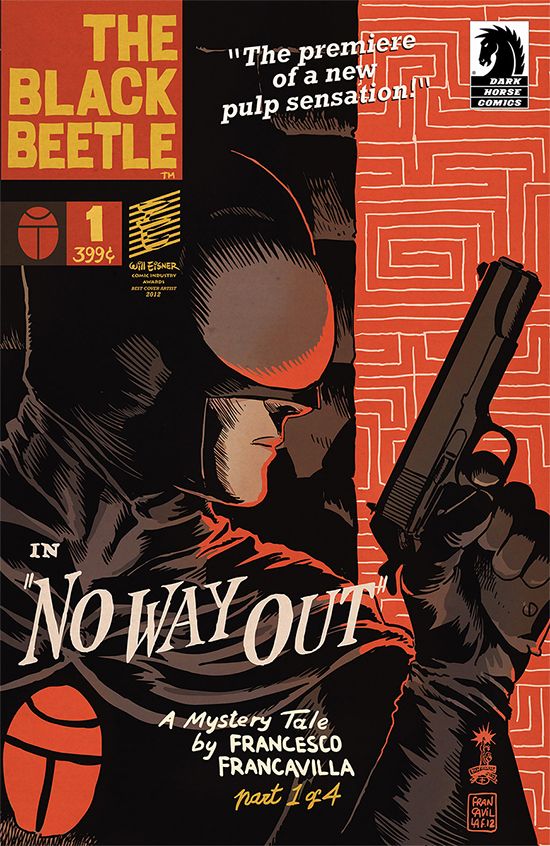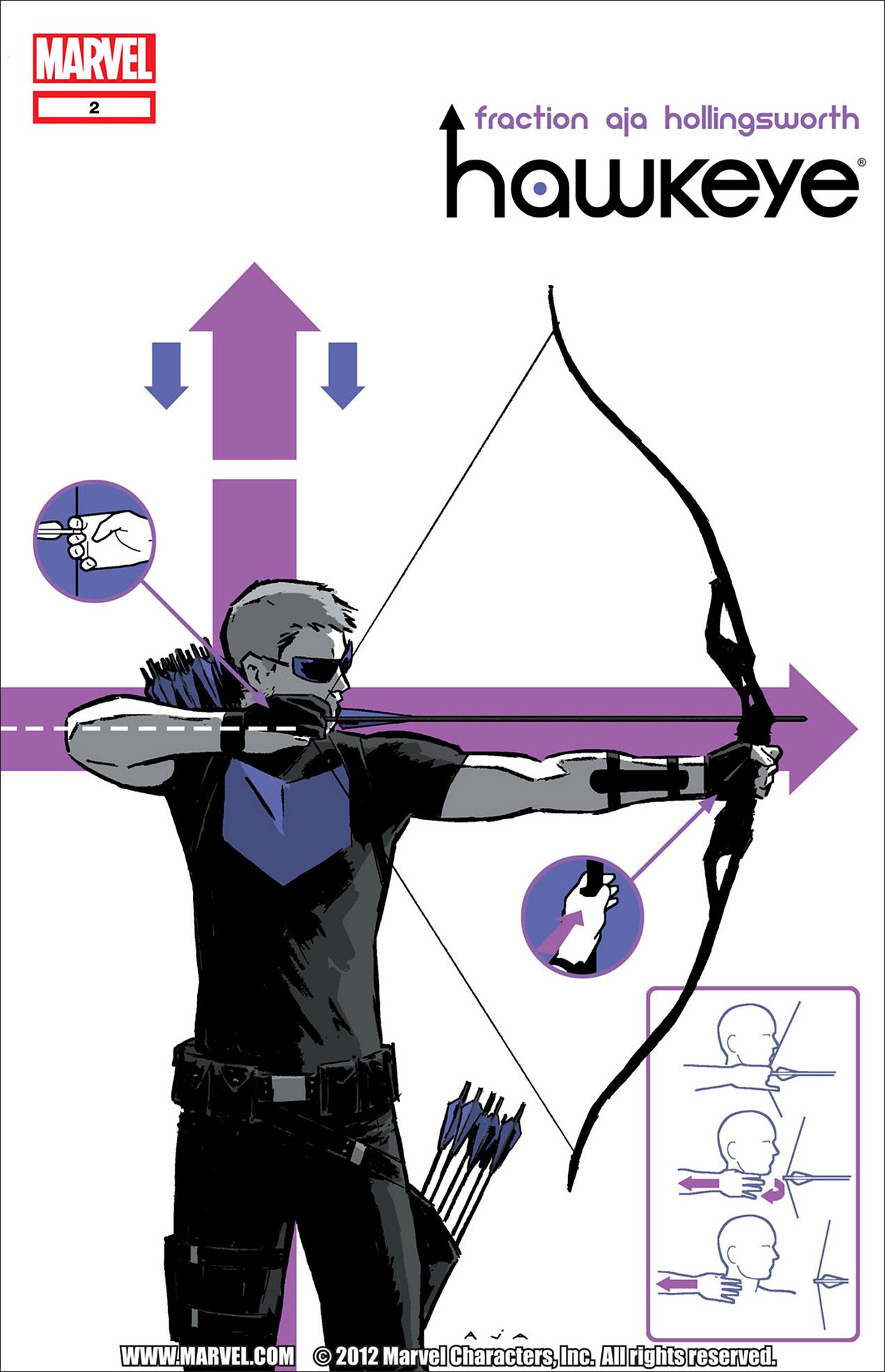Hello and welcome to What Are You Reading?, where the Robot 6 crew shares their picks for the Royal Rumble ... I mean, talks about what comics we've read recently. Today our special guest is Landry Walker, writer of Danger Club, Supergirl: Cosmic Adventures in the Eighth Grade, Batman: The Brave and the Bold, Little Gloomy, Tron and more.
To smell what Landry and the Robot 6 crew are cookin', click below.
*****
Tom Bondurant
Yea verily I asked for, and the e-commerce provided unto me, a well-traveled copy of Adam Warren's miniseries Dirty Pair: Fatal But Not Serious. It was my first real exposure to the DP after hearing so much about them (and, of course, after all these years of following Empowered). It did not disappoint. This miniseries finds Kei and Yuri on their way to a convention in their honor, only to have Kei attacked by a killer clone. The joke running throughout the story is that our heroes leave apocalyptic numbers of casualties in their wake, and that gives FBNS its ticking clock. Naturally, it also allows for a good bit of black humor, with a couple of vapid holograms providing running convention commentary. Overall I liked it a lot, and I can see where Empowered might in some ways be a response to the over-the-top sex-and-death themes of these earlier comics. Another volume (Biohazards) is on the way, but I hope Dark Horse starts reprinting these -- the two I have were hard enough to track down.
Batwoman #16 (written by JH Williams III and W. Haden Blackman, drawn by Williams) amps up the action in the big team-up with Wonder Woman. Occasionally I mention how the Wonder Woman/Superman relationship could potentially conflict with her portrayal in her own book, and I forget that for the past few months, she's been a regular guest-star in Batwoman. I suppose this is because I have no complaints about how she's portrayed in Batwoman. In fact, her presence almost single-handedly justifies all the monsters and mayhem. Sometimes I think we forget that Batman et al. used to go into space and/or to other dimensions with the Justice League and the Titans, so why shouldn't Batwoman fight Medusa? Great character bits in this issue too, particularly Kate's reaction to the destruction, the dramatic entrances of two supporting characters, and the emergence of unexpected allies. Williams and Blackman use first-person narration to good effect, offering shifting perspectives on the battle. I'll miss Williams' art, but as long as the writing doesn't suffer, I won't be disappointed.
Finally, as far as unorthodox team-ups go, Green Lantern #16 (written by Geoff Johns, pencilled by Doug Mahnke, inked by committee) has given me a new favorite Lantern pair. In the '80s there was John/Katma, in the '90s there was Kyle/Jade, for the past few years it's been Hal/Sinestro, and now it's Simon/B'dg. Some of you may want Kilowog training rookie GLs, but I will take the talking extraterrestrial squirrel, thank you very much. He teaches Simon the GL oath, gives him the basics of ring-slinging, and watches as Simon tries to do the impossible with a ring which is supposed to do just that. A good "emerging superhero" issue all around, and the Hal/Sinestro plot moved forward too. Green Lantern has been in perpetual-crisis mode since before the New-52 relaunch, but if this keeps up, it might not be so bad.
J. Caleb Mozzocco
I caught up on the last couple Wednesdays worth of comic book-comics, which I reviewed at some length on my home blog, so I won't get into them again here.
As for comics I read this week that I didn't review anywhere else already, there were but two: Thien Pham's Sumo and Ross Campbell's Wet Moon Vol. 3.
Pham was the artist who collaborated with Gene Luen Yang on the thoroughly charming book Level Up, and with Sumo he's handling writing, drawing and (everything else, too) himself. It's a rather short, quite graphic novel about an American student of prodigious size who doesn't make it into the NFL, and opts to move to Japan to try making it in another sport for really large men.
Pham's style is very simple and abstracted, especially in this book, and he uses color to divide the story up into different sequences of time, jumping from one to the next and back again before finding a series of climactic moments in each. It's a serious story, but it has light moments, and I really enjoyed the simple pleasure of Pham's cartooning as applied to his protagonist. There's just something very funny about a very, very large man sitting in small places like airplanes and Japanese movie theaters. (That, or I'm easy to please, I guess).
It's published by First Second, who previously published Foiled, a YA fantasy novel based around fencing. Sumo makes a nice companion book in that it's another winning graphic novel about a fairly obscure sport based on an outmoded style of combat that I don't know anything at all about. I wonder if someone's working on a lacrosse graphic novel for First Second as we speak...? (And by "As we speak," I mean, "As I type this" and/or "As you read this.")
Campbell's Wet Moon is a lot less straightforward than his other, shorter comics works (Shadoweyes, Water Baby, The Abandoned) in that it has a fairly gigantic cast and the plot mainly revolves around the various members of that cast hanging out, coupling and talking about coupling while hanging out, with something quite strange, mysterious and probably supernatural occurring every once in a while.
The thing about the comic though is that it is so well drawn that half the time I don't even really care what's going on. Campbell is such a great artist, and such a great character designer, that it's a blast just to look at his panels and the faces and figures in them. I like just hanging out with these characters in this comic, the voyeuristic pleasure that comes from looking at 'em through the frames of the panels Campbell puts around them, and overhearing their sometimes dramatic, sometimes funny, often uncomfortably realistic conversations.
Mark Kardwell
This week I got around to reading a few books from the last couple of years that lingered too long on my Amazon wishlist. These included Garth Ennis and Goran Parlov's Fury Max: My War Gone By, Robert Sellers and JaKe's Hellraisers, and Joe Casey and Mike Huddleston's Butcher Baker The Righteous Maker. The Ennis/Parlov book is good, but familiar, stuff: Ennis working through tropes he's dealt with many times before, but doing it well enough that you don't mind at all, Parlov is his usual amazing, slick, self. Hellraisers is one of those rare things, a biographical comic I liked. It captures its subjects voices well, largely by giving them actual quotes from past interviews. That works, and JaKe's art is another rare thing, a cartoonist with a deceptively loose style who draws likenesses with ease. This is presumably why he's so popular with the folks at Lucasfilm: he'll draw you a cute wookiee, but beside it will be a very recognizable Harrison Ford. Anyway, this is a lovely book that hits the bittersweet, elegaic note it was clearly reaching for, throughout. Butcher Baker is completely apesh!t crazy, but that always seems to have been the intention of all involved, making it hard to criticize. It looks good, it reads fast, and everyone enjoys themselves. Mission accomplished.
I also read 2000AD prog 1817, the latest issue of the comic to receive some hysterical over-reactions from mainstream press outlets in the UK (page three of yesterday's The Sun — cheers, Rupert!), something of a tradition for the venerable anthology. The issue doesn't officially hit the shelves until Wednesday, so I won't spoil it for anyone. Needless to say, it's another case of a fine strip dealing sensitively with a contentious subject, with a ridiculous over-reaction being made by people who presumably haven't (or will never) read it yet.
I'd like to add my voice to all the online praise for Madeleine Flores' new webcomic Help Us Great Warrior. Kenny Penman of Blank Slate sent me a copy of her book The Girl and The Gorilla a couple of years ago, and I remember thinking if this is what this kid is capable of so young, what will her work be like in a few years? And yeah, her writing is still funny and charming, but now with even better comedic timing. Her artwork has also improved in leaps and bounds, developing real muscle. Great stuff, highly recommended.
Tim O'Shea
The Black Beetle 1: In my dream world Francesco Francavilla’s Black Beetle becomes the new Hellboy for Dark Horse. The writer/artist makes a car being driven down a straight road interesting in this pulp adventure, for the love of God. Maybe it was because Jim Steranko has a blurb in praise of him in this first issue (of a four-part miniseries) of this “No Way Out” arc, but I actually saw a hint of Steranko-esque influence on Francavilla’s layout. In terms of small details, I love that the story takes place in a Colt City. While he is not the first to use the name, it is just so apt for this series.
Dark Avengers 185: Writer Jeff Parker is settling into the new team dynamics in this ongoing and it is enjoyable to see where he takes certain characters. Right out of the gate, June Covington/Toxie Doxie is becoming a character of note. Meanwhile artist Neil Edwards is having a field day designing the alternate universe characters—in this issue, his Ben Grimm/Thing redesign is exquisite.
Winter Soldier 14: Much like Ed Brubaker’s Cap, it almost seemed like his Winter Soldier ran out of steam toward the end of his run. I am much more enthused to see what Jason Latour does with the character. But, no doubt, the early chunk of this Brubaker series was exquisite to read, particularly given the outstanding layout eye of Butch Guice. Also, while Brubaker has likely said this numerous times before, I had never known (as he mentioned in this issue’s goodbye note) that he partially felt a kinship to Bucky, having been raised on military bases himself. That’s a detail that will inform my take on his Steve Rogers and Bucky work when I eventually go back to re-read them. While this issue is not the Brubaker coda I would have wanted, I did enjoy immensely 90 percent of his work on Cap and Bucky. Hell, I would not be writing about James Barnes/Bucky were it not for Brubaker.
FF 3: Every aspiring or young (or old, for that matter) artist needs to be reading this book for the education Mike Allred is offering in terms of kinetic layout. It makes my impression that Matt Fraction’s plot seems to be moving slower than molasses tolerable. And of course, I think if not writing a corporate comic (with editorial mandates) Fraction would be moving the plot at a quicker pace. I do hope that Fraction uses Wyatt Wingfoot more. Added bonus on the Allred front? He gets to give future Johnny Storm an Allred character look. Finally I would be remiss in a week where we learned to appreciate colorists more (thank you, Jordie Bellaire) to shout from the rooftops: “Is there a more powerfully colored comic than one done by Laura Allred?” I think not.
Wolverine and the X-Men 24: I am certainly surprised at the subtle depth that Jason Aaron is working into Quentin Quire’s character with each issue. Glad to see the Broo subplot continues to advance. But as much as I enjoy the series, can we all take a moment to laugh at the absurdity that Wolverine’s claws were used to cut Storm’s hair this issue? Forget the other major developments with Storm and Logan in this issue, the haircut (maybe intentionally) had me cracking up.
Captain Marvel 9: I wonder if writer Kelly Sue DeConnick prefers to work with unique artists on this series. To date, none of the artists have drawn in the (for lack of a better term) traditional manner. In the case of Dexter Soy, I literally cannot read the comic; his style (and awkward eye for layout) is so oft-putting. In the cases of Emma Rios and this issue’s Filipe Andrade, while their respective styles are non-traditional, there remains a basic understanding of human anatomy and layout, that I am able to enjoy the story. This issue is a “day in the life of Carol Danvers” story, which works quite effectively and engagingly—ending with good narrative punch in the gut. For all my enjoyment, however, Andrade’s style does not always convey emotion effectively—in this issue there is a moment where the script/dialogue calls for Captain Marvel to have a flash of annoyance/defensiveness/anger (what have you) with Jessica/Spider-Woman. I was able to pick that up from the dialogue—nothing in the characters body language or facial expression conveyed that. This is a quibble however, as this issue is a great jumping on point (I had bailed after the Rios arc) and I will be picking up the next issue—which will again have Andrade on art.
Landry Walker
What am I reading? Not enough. That much I’m sure of. Time is limited these days and I’m always hesitant to start reading something that will derail my thoughts and lead me off course of a deadline. Regardless, there are a few books out there I cannot ignore.
Hawkeye 1-6: I only just dived into this series, and praising it seems to be a case of preaching to the choir. It’s a good book. You already know this. You’ve already read it. But just because it can be assumed that everyone already knows doesn’t mean the praise should be withheld. This is the kind of comic the industry needs if it is to survive. The kind of comic that makes people like me want to be better and want to try harder. This comic is GOOD.
Grendel Omnibus Volume 2: The Legacy: I was lucky enough to be introduced into the mad world of Christine Spar back when it was first published by Comico. Decades later the Nagel-esque style of the Pander Brothers seems dated on first glance. But as I re-read the comic and am drawn further and further into the storytelling, the sense of retro-nostalgia is quickly shoved aside in place of absolute enthrallment – a sense that is only heightened by the time I reach the sad tale of Brian Li Sung and the reflections of Captain Wiggins. These are comics that transformed the landscape, and revisiting them is an absolute necessity. My only complaint is with the format. The book is too damn small.
The Action Heroes Archives Vol. 2 (DC Comics): This is something I seem to continually revisit, and in a Before Watchmen world it feels doubly important to revel in the comics material that really were before Watchmen. Somewhere I have all the original issues tucked away, but I much prefer the ease of the hardcover collected edition. Just a pity that the Toth/Question issue of Charlton Bullseye wasn’t collected along with this – probably for legal reasons.
The Legend of Luthor Strode: I honestly have no idea where Justin Jordan is taking this, and that intrigues me. In the last series he delivered insane amounts of violence so perfectly, that within short order it becomes invisible, allowing the characters to shine. I have no doubt this second series will do the same.

